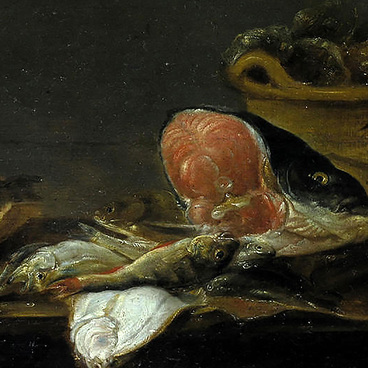Painting played a leading role in the art of Flanders in the 17th century. There were hundreds of artists, both famous and those whose names have not survived to this day. The leader of the Flemish school of painting was Peter Paul Rubens. He ran a huge workshop, where not only young painters but also established artists trained and worked.
“Apollo and Marsyas”, inspired by ancient mythology, was also produced the master’s studio. The creator of the painting is unknown. However, the work shows all the signs of classical work of the Flemish school including monumentality, realism of the image, attention to detail, bright vivid characters, exuberant colors, etc.
The picture is based on an ancient Greek legend. Satyr Marsyas found a flute in the woods and learned to play it so beautifully that he challenged the patron of the arts, the god Apollo, to a musical contest. After winning the musical battle, the god decided to punish Marsyas for his impudence: he tied Satyr to a tree and stripped his skin off.
It is this moment of the myth that is captured in the painting. The young man of athletic build with lush reddish hair, beautiful features and snow-white skin is Apollo. The god of the sun, the god of art, the possessor of perfect beauty peels the skin off the second character, the satyr Marsyas. The artist contrasts the characters. Although the Satyr’s figure is also well built and muscular, his dark skin, round snub-nosed face, and bald head create the image of a commoner. This is how the inferior deities were portrayed.
The conflict in the painting is embodied in many ways: by dividing the background diagonally into two parts, by contrasting the lighter figure of Apollo with the darker one of Marsyas, and by showing their opposing emotional states. On the left side of the painting, there is calm and serene Apollo, executed in gray-blue, “heavenly” tones that symbolize the world of the gods. On the right, using darker colors and darker shades, the artist depicts the earthly world, the forest, in which one of his spirits, the satyr Marsyas, is dying writhing in pain.
The figures of the characters in the painting mirror each other. Their feet, resting firmly on the ground, form a triangle. The raised arms suggest dancing movements. Broad, powerful strokes in the spirit of the painterly manner of Rubens embody baroque expression. The work was painted on wood, but in 1820 was transferred to canvas. The vertical line left from the joining boards can still be traced with the naked eye.
“Apollo and Marsyas”, inspired by ancient mythology, was also produced the master’s studio. The creator of the painting is unknown. However, the work shows all the signs of classical work of the Flemish school including monumentality, realism of the image, attention to detail, bright vivid characters, exuberant colors, etc.
The picture is based on an ancient Greek legend. Satyr Marsyas found a flute in the woods and learned to play it so beautifully that he challenged the patron of the arts, the god Apollo, to a musical contest. After winning the musical battle, the god decided to punish Marsyas for his impudence: he tied Satyr to a tree and stripped his skin off.
It is this moment of the myth that is captured in the painting. The young man of athletic build with lush reddish hair, beautiful features and snow-white skin is Apollo. The god of the sun, the god of art, the possessor of perfect beauty peels the skin off the second character, the satyr Marsyas. The artist contrasts the characters. Although the Satyr’s figure is also well built and muscular, his dark skin, round snub-nosed face, and bald head create the image of a commoner. This is how the inferior deities were portrayed.
The conflict in the painting is embodied in many ways: by dividing the background diagonally into two parts, by contrasting the lighter figure of Apollo with the darker one of Marsyas, and by showing their opposing emotional states. On the left side of the painting, there is calm and serene Apollo, executed in gray-blue, “heavenly” tones that symbolize the world of the gods. On the right, using darker colors and darker shades, the artist depicts the earthly world, the forest, in which one of his spirits, the satyr Marsyas, is dying writhing in pain.
The figures of the characters in the painting mirror each other. Their feet, resting firmly on the ground, form a triangle. The raised arms suggest dancing movements. Broad, powerful strokes in the spirit of the painterly manner of Rubens embody baroque expression. The work was painted on wood, but in 1820 was transferred to canvas. The vertical line left from the joining boards can still be traced with the naked eye.



